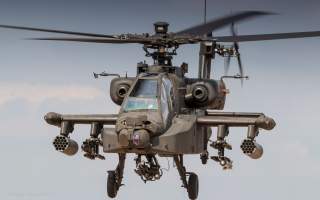Civil War Fact: The Confederacy Almost Developed a Helicopter in 1862
But the technology wasn’t quite ready for Robert E. Lee’s air cavalry.
It’s the third day of the Battle of Gettysburg in July 1863 and Union forces on Cemetery Ridge await the final Confederate assault. But instead of witnessing serried ranks of rebels marching across a mile of open ground into the maws of Yankee cannons, the bluecoat regiments are shocked to hear the thud of rotor blades.
It is the sound of Confederate general George Pickett’s 13,000-strong division landing behind Union lines.
Is this a neo-Confederate dream? The Red Badge of Courage meets Apocalypse Now?
No, it turns out that a Confederate engineer actually did design a helicopter back in 1862.
William C. Powers was an architectural engineer in Mobile, Alabama. Frustrated by the Union blockade of Mobile and other Southern ports, which prevented the Confederacy from exporting cotton and importing weapons, Powers resolved to devise a way to destroy Union ships.
The Confederate Navy was far too weak to confront the Union fleet, even with a primitive submarine like Hunley. Both the Union and Confederacy had aerial balloons for observation. However, the balloons were neither maneuverable nor had enough lift to carry any real armament.
So, Powers designed a steam-powered maritime strike helicopter to rain bombs down on Union heads. It drew upon many of the ideas of Archimedes and Leonardo da Vinci, according to Tom Paone, a museum specialist in the Aeronautics Department of the National Air and Space Museum in Washington, D.C.
Paone described the helicopter in an article for the museum:
The engine was located in the middle of the craft and used two smokestacks, which can be seen in the drawings. Two Archimedean screws on the sides gave the helicopter forward thrust, similar to how a propeller works on a ship in water, and two mounted vertically in the helicopter gave it lift. A rudder was added to the rear of the craft in order to provide steering.
“I presume from the drawings that it would have had a maximum crew of two,” Paone wrote in an email to War Is Boring. “And presuming the hull is between five and six feet tall, then it would seem to be 20 to 30 feet tall, 20 to 25 feet long, and 10 to 15 feet wide.”
“But these are all very rough estimates,” Paone added.
The helicopter might seem like something that might have come out of a Renaissance workshop, but it featured the advanced construction techniques developed a full century later. Lattice construction, which confers structural strength without adding much weight, was a major feature of the World War II British Wellington bomber.
Though Powers built a small model and then a full-sized mockup, he lacked the resources to produce a working helicopter. His family eventually donated the plans to the museum.
If he had built a Confederate whirlybird, would it have flown?
“I am certain that this craft could not have flown,” Paone told War Is Boring. “The craft was supposed to be powered by a steam engine, and the technology at the time didn’t allow for an engine that was light enough or powerful enough to power the craft.”
“The other issue is that the vertical propeller shafts would not have produced lift,” Paone continued. “If the Archimedean screws were made of a solid material, they would have been far too heavy for the craft. If they were made of some sort of stiffened canvas, it is doubtful that they would have produced any lift.”
Even if the Confederate chopper had staggered into the air, it is unlikely that it could have dropped any bombs powerful enough to do much damage.
Besides being hampered by lack of material, Powers refrained from building a helicopter because of fear that “it would be captured by the Union, mass produced and used to rain destruction on the Confederate armies and cities throughout the South,” Paone wrote.
For those Confederate nostalgists who dream of Robert E. Lee’s air cavalry capturing Washington or Confederate bombers pounding New York, that last point is worth remembering.
The Union won the Civil War because its industrial economy overpowered the largely agricultural Confederacy. Whatever number of helicopters the Confederacy could have built, the Union factories would have churned out more.
So instead of Pickett launching an air-mobile assault behind Cemetery Ridge, Grant’s Army of the Potomac could have bombed Richmond or dropped behind Confederate fortifications at Cold Harbor.
This article by Michael Peck originally appeared at War is Boring in 2017.
Image: Wikimedia

